Before covid-19, the World Health Organization had classified stress as the health epidemic of the 21st century.[1]
While it would be foolish to say that workplace stress has had anywhere near the devastating impact as covid-19, it would be fair to say that workplace stress has had its own long, slow burn on global physical and mental health. According to a recent survey, 94% of American workers are experiencing job stress.[2]
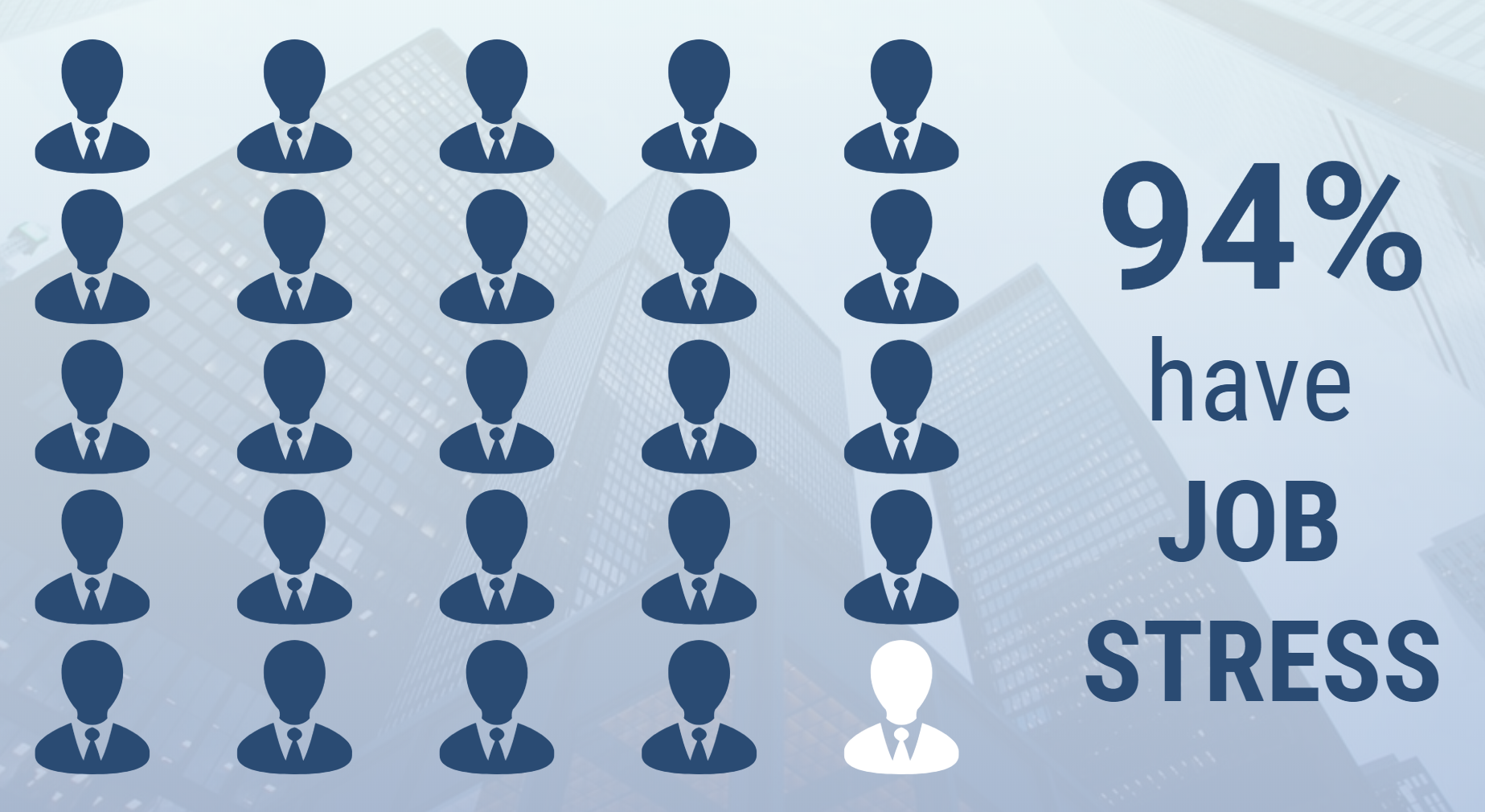
Image by Pamela Coburn-Litvak on Venngage
In this article, I will summarize workplace stress data from multiple sources. Some of this data comes from for-profit companies that serve the business community; other data comes from non-profit organizations that keep their fingers on the pulse of stress in the United States and around the world.[3]
Using this information, we will review:
- the top sources of job stress,
- the impact that job stress has on us obht professionally and personally,
- generational differences in job stress, and
- how we deal with stress.
This will provide the foundation we need to understand the most powerful ways to resolve stress in our lives. I will introduce you to a stress management model that has been developed by stress researchers and experts for over twenty years.
What Stresses Us Out at Work? Top Sources of Job Stress
There are two main sources of workplace stress: the work itself and the people who do the work. These are of course intricately linked. The systems and processes we use to do the work itself are, after all, designed by people…at least for now (Hello, A.I.). And when we get stressed out by work and deadlines, our relationships with others can become even more strained.
The top sources of stress include the following:
Poor Communication
At least two surveys of U.S. and U.K. workers list poor communication as the number one stressor in the workplace. According to Dynamic Signal, 80% reported feeling stressed over ineffective and fragmented communication within their companies. Likewise, Wrike reported poor communication as the biggest problem for both large and small companies.
Poor Support
In a survey of nearly 10,000 workers by Mental Health America (MHA), 60% said their supervisor did not regularly check on their needs in the workplace. Promoting a culture of safe and open communication fosters better performance. In the MHA survey, safe and open communication was directly linked to greater employee motivation, confidence, and pride in the workplace. On the other hand, people who were the most stressed also reported that they were in companies where it seemed safer to remain silent about personal problems. Sixty-nine percent of those surveyed said that it seemed safer to remain silent about workplace stress. Fifty-five percent were afraid to take time off to attend to their mental health.
Poor Relationships & Poor Collaboration
A close second was poor collaboration, e.g. team members not pulling their weight in the workplace. In a survey done by the Anxiety and Depression Association of America (ADAA), 53% reported interpersonal relationships as a main culprit of job stress.
Poor Control Over Projects & Processes
Other stressors included dealing with unforeseen problems and issues, having unrealistic deadlines, struggling with work overload and overwhelm, and bottlenecks in organizational processes.
What Impact Does Job Stress Have on Us?
Professional Impact of Job Stress
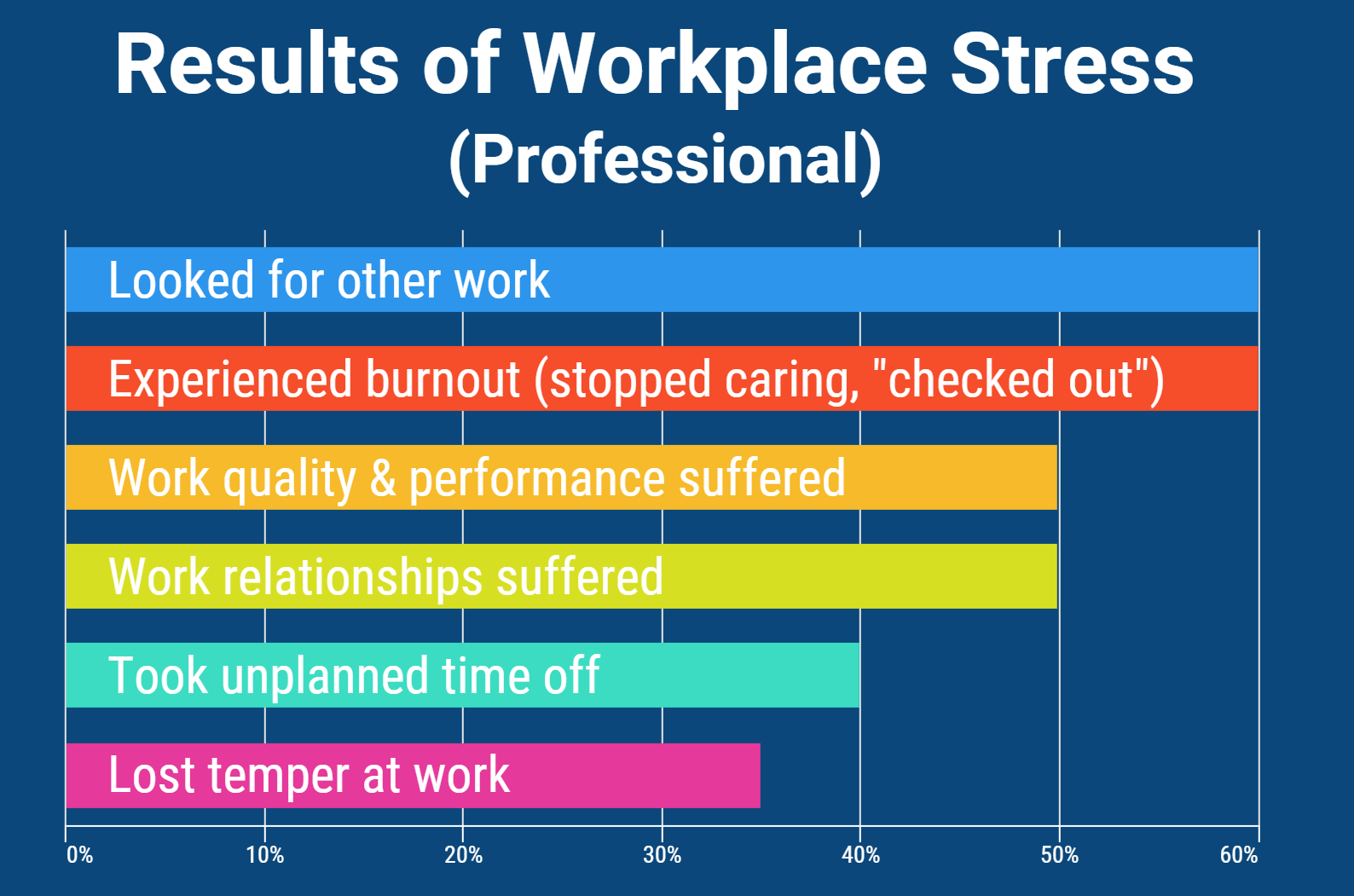
Image by Pamela Coburn-Litvak on Venngage
Employers may be thunderstruck to know that up to 50-60% of their workforce is regularly looking for other jobs at least several times a week due to their job stress. According to the MHA Survey, over half of those surveyed would not recommend their workplace to others; one in five would strongly advise against it.
Those who are at work are often mentally checked out – they’ve stopped caring about what happens. Nearly 60% of those surveyed by Mental Health America reported this sort of burnout, with 24% feeling severe burnout. And burnout is costly. According to Gallup, checked out employees cost companies $450 to $550 billion in lost productivity every year.
Not surprisingly, work performance and quality are universally reported to slump as stress levels rise. According to the ADAA survey, 51% reported that stress and anxiety was impacting their relationships with coworkers and 43% reported problems with their superiors. As a result, many started to avoid social situations at work (73%), became short-tempered (53%), and avoided participating in meetings (43%).
According to the Wrike survey, nearly 40% took unplanned time off to deal with their stress; 35% lost their temper at work.
Personal Impact of Job Stress
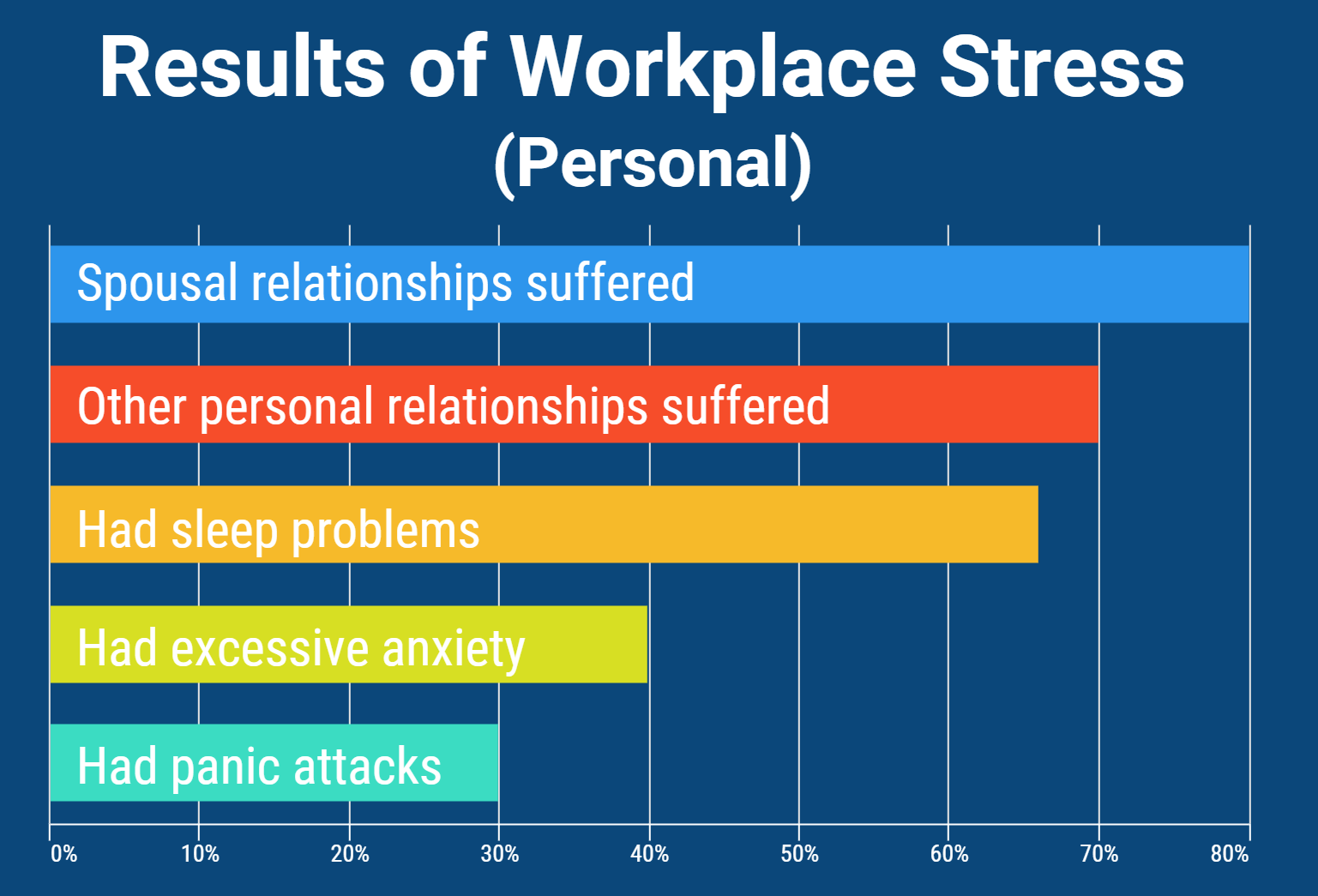
Image by Pamela Coburn-Litvak on Venngage
It’s important to realize that job stress impacts more than just our work life. Without exception, all surveys reported that it bleeds over into our personal lives and relationships. Seventy percent of those in the ADAA survey reported that job stress affected personal relationships, mainly with spouses. This agrees with results from the consulting firm Korn-Ferry –78% reported that job stress inevitably impacted personal relationships.
Another consistent finding across research surveys is job-stress related issues in getting quality sleep. Over half of survey respondents reported that stress was keeping them up at night.
Forty percent of those surveyed by the ADAA reported having excessive anxiety and 28% reported having had an anxiety or panic attack. When asked what triggered those attacks, over half (53%) mentioned job stressors like deadlines, interpersonal relationships, and job changes like leaving a job, starting a new one, or getting fired.
Does Job Stress Affect Different Generations in Different Ways?
Morneau Shepell, a HR management firm, recently published a series of white papers on the impact of stress-related disorders like depression and anxiety on work performance. They broke this data down by generations currently in the workplace:
- Millenials (Gen Y): born 1978-1999
- Generation X (Gen X): born 1965-1977
- Baby Boomers (Boomers): born 1946-1964
Data from the youngest generation (Generation Z, born after 1999) and the oldest (Traditionalists, born 1927-1945) was omitted due to low sample size.
Rates of Depression & Anxiety
Overall, 27% of those surveyed by Morneau Shepell reported experiencing anxiety, and 17% reported depression. Millenials reported the highest levels of both – about one in three reported anxiety and one in five reported depression.
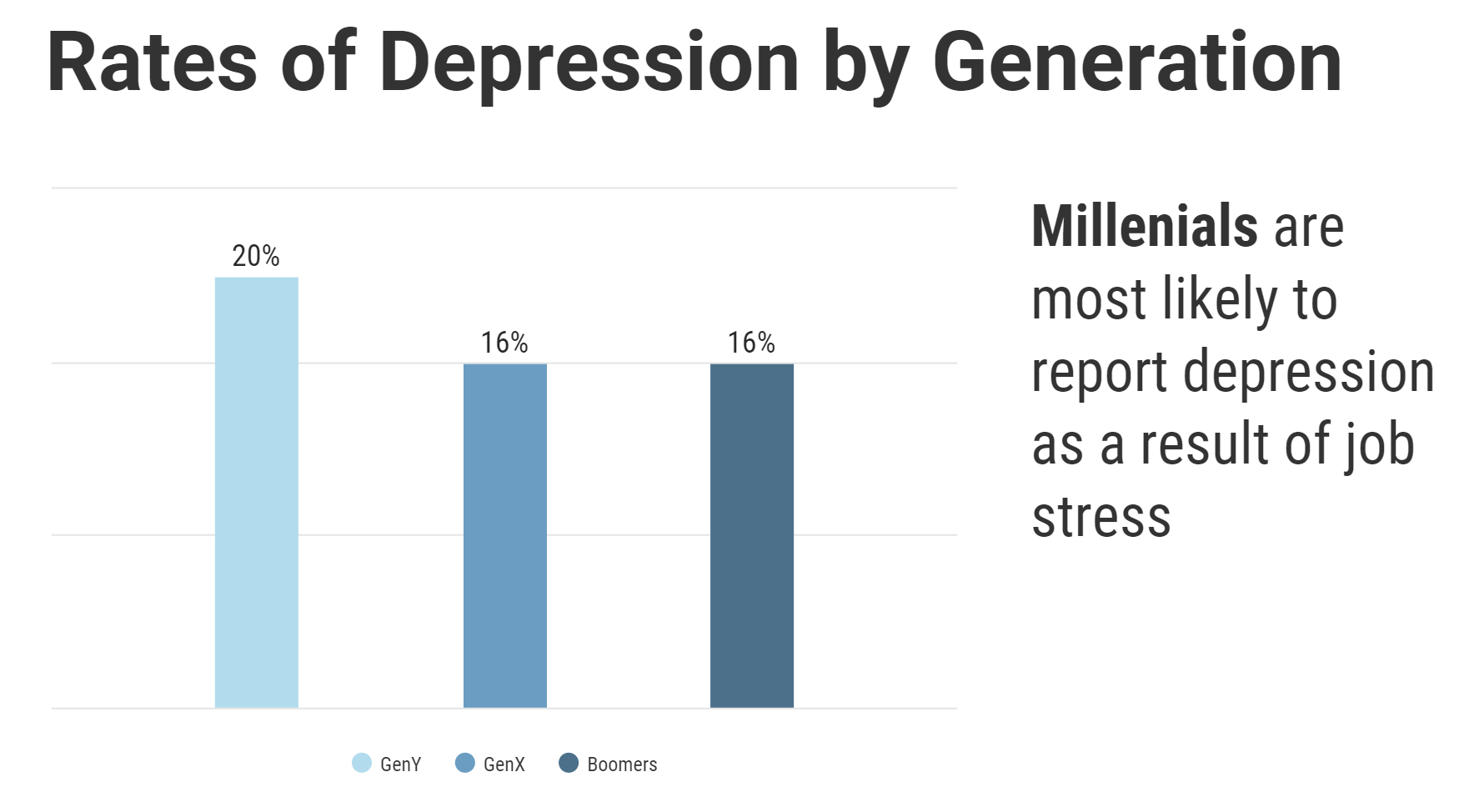
Image by Pamela Coburn-Litvak on Venngage
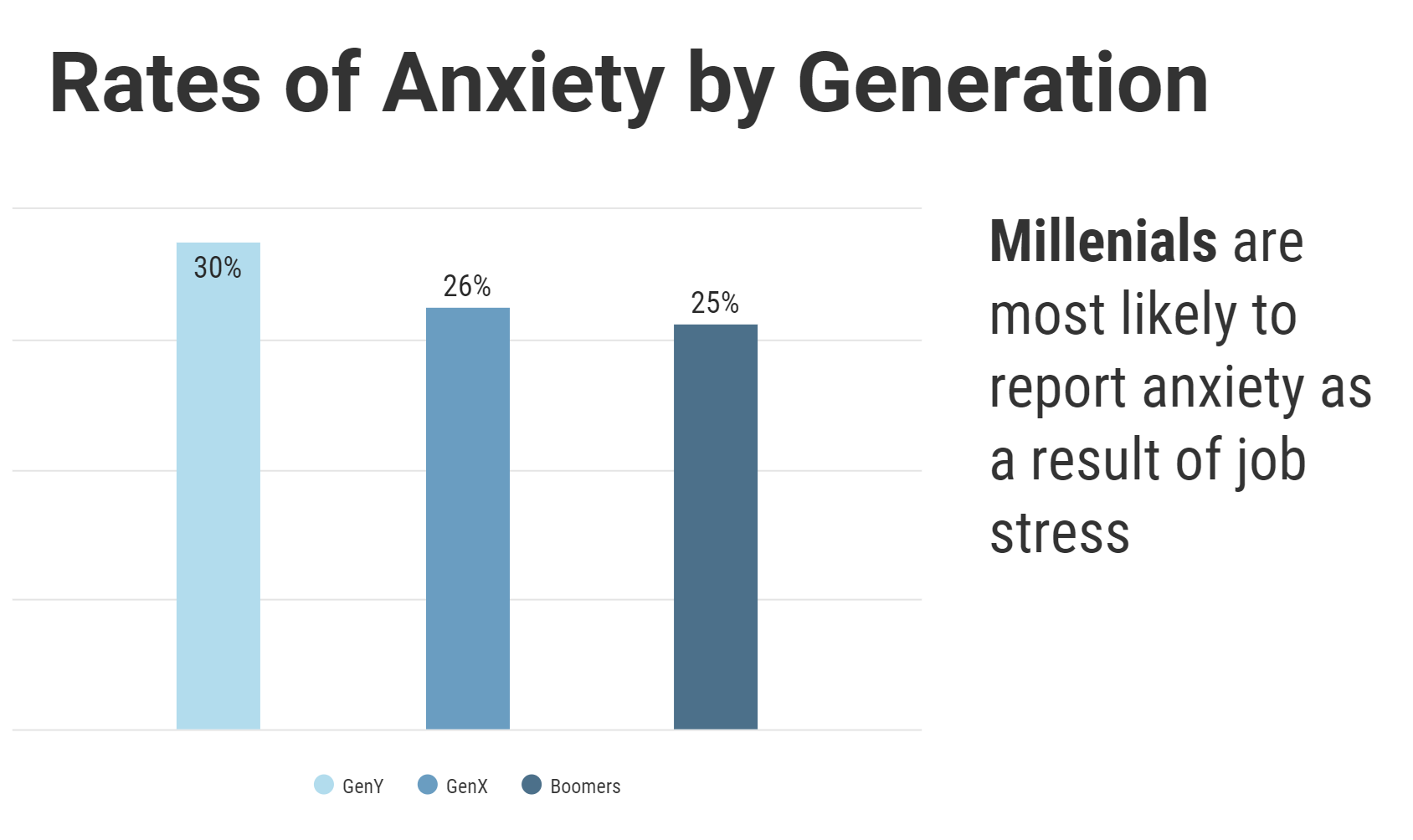
Image by Pamela Coburn-Litvak on Venngage
Gen X and Boomers still had significant anxiety – one in four of each generation reported this in the survey. Their rates of depression were lower, affecting about one in every 6 or 7 in each generation.
Morneau Shepell also investigated the impact of anxiety and depression on work performance. Like the surveys above, they found high rates of “presenteeism” – people showing up but remaining disengaged at work.
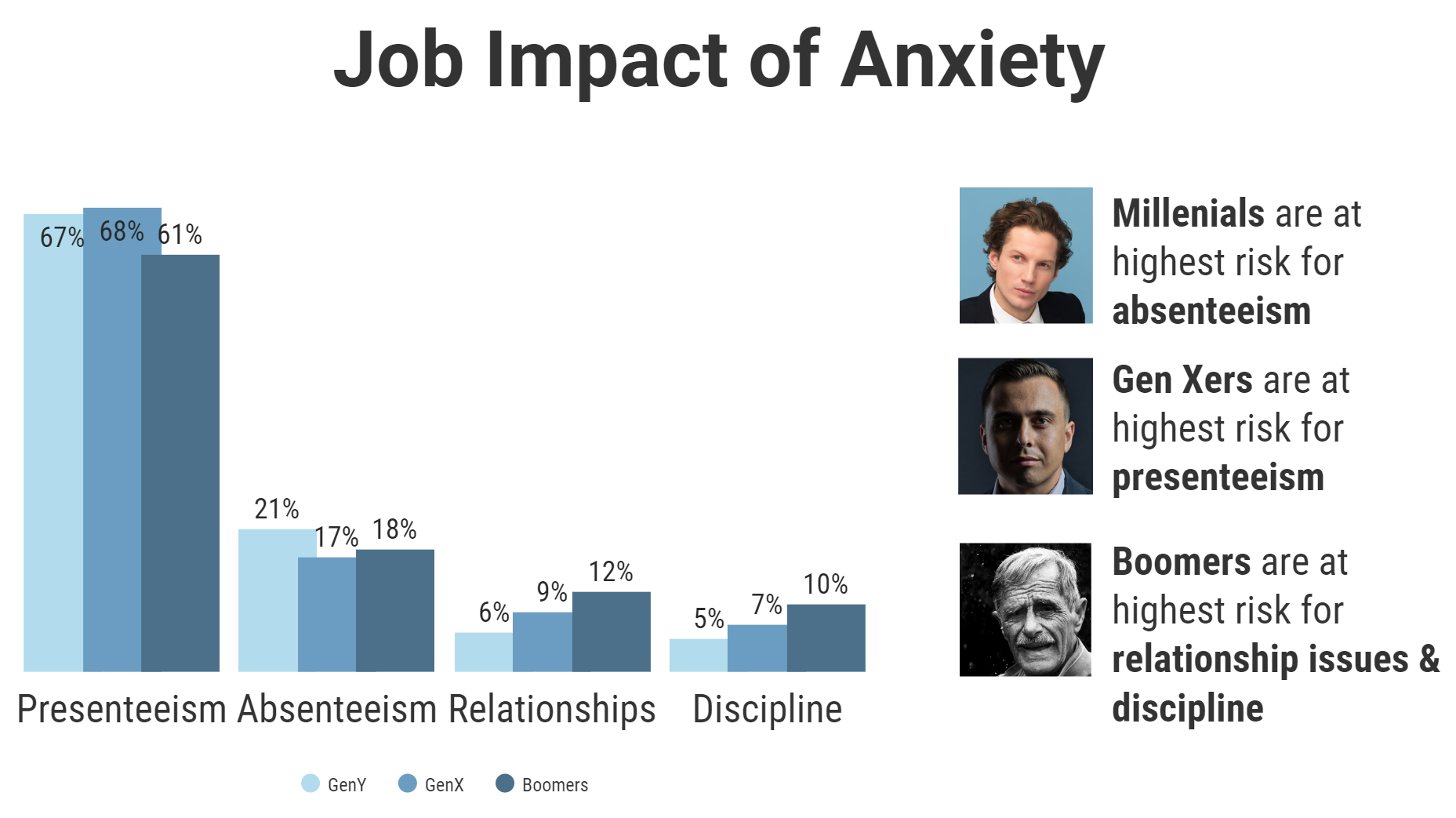
Image by Pamela Coburn-Litvak on Venngage
When feeling anxious, millennials (Gen Y) were slightly more likely to take time off and thus had higher rates of “absenteeism” than Gen Xers or Boomers. Boomers were twice as likely as Gen Y to experience conflict and relationship problems due to their anxiety.
When feeling depressed, Gen Xers were slightly more likely to display “absenteeism” than Boomers or Gen Y. Boomers still had more problems with conflict and relationships than the other generations.
Best Stress Management Strategies for Job Stress
Before I tell you the best strategies, I’ll share some results of how we tend to deal with job stress from survey data. The Anxiety & Depression Association of America found some interesting differences between men and women in handling their job stress. Here are the respective lists of stress management techniques, from most popular to least:
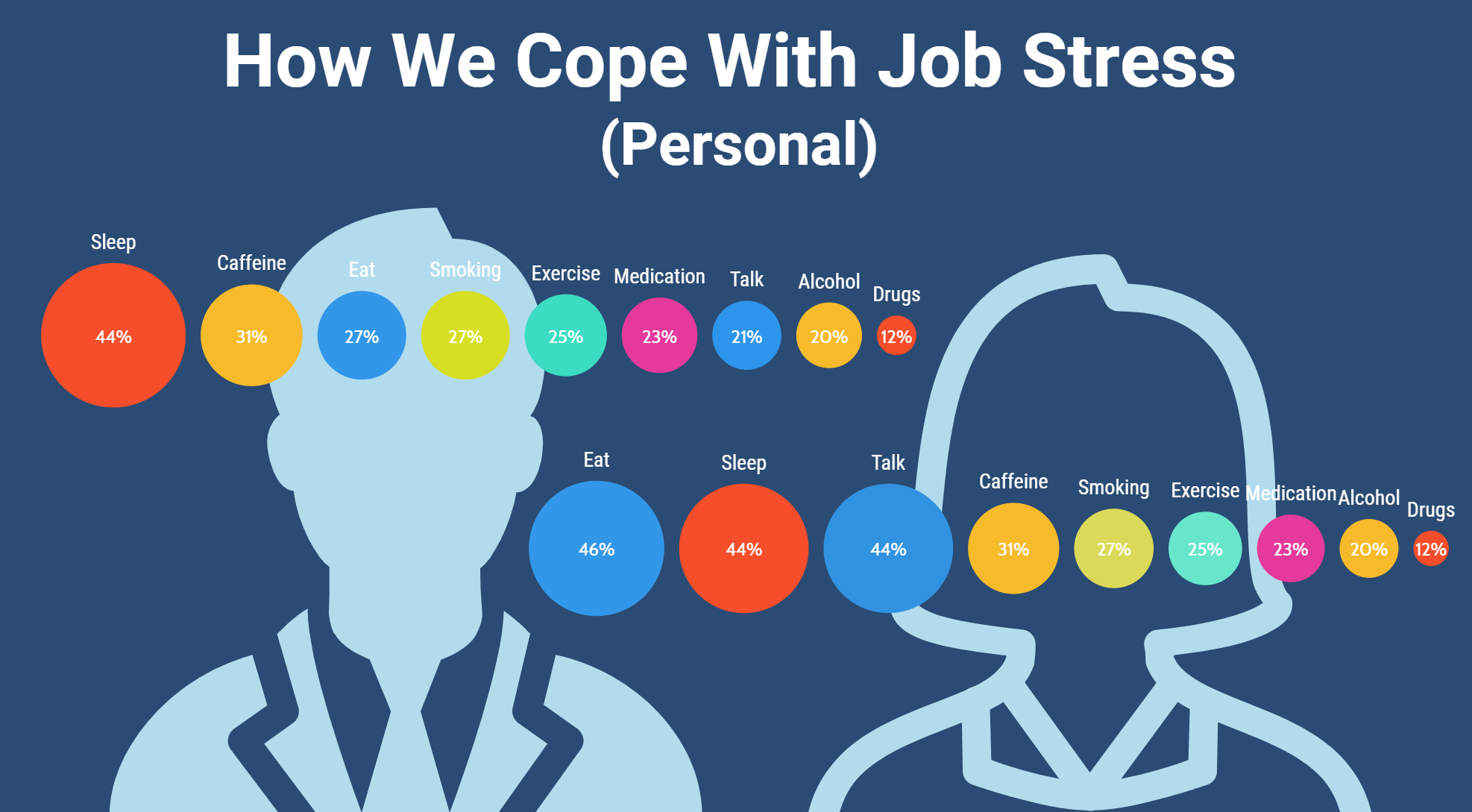
Image by Pamela Coburn-Litvak on Venngage
Gender Differences in Stress Management Strategies
Men and women share some similarities, but also some differences, in how they handle job stress.
Women
Men
Conclusion:
Women and men differ somewhat in their top stress strategies. While both tend to sleep more, women also choose to eat (46%) and talk to family and friends (44%) while these fall further down the list for men (eating 27% and talking 21%). Both used some strategies at the same rate: caffeine (31%), smoking (27%), exercise (25%), over the counter or prescription drugs (23%), and alcohol (20%).
You can see that both healthy (e.g. sleep, talking, exercise) and unhealthy (e.g. alcohol, illicit drugs) choices made both lists. It’s probably worth noting that all of this data was self-reported, meaning those taking the survey had to feel comfortable sharing their stress management strategies. This could mean that healthy choices were over-reported and unhealthy choices were under-reported.
I don’t say this to criticize. Heaven knows, when we are struggling with feelings of frustration, worry, and anxiety, we do not always make the wisest choices.
But it is important to know which stress management methods are likely to get the best results.
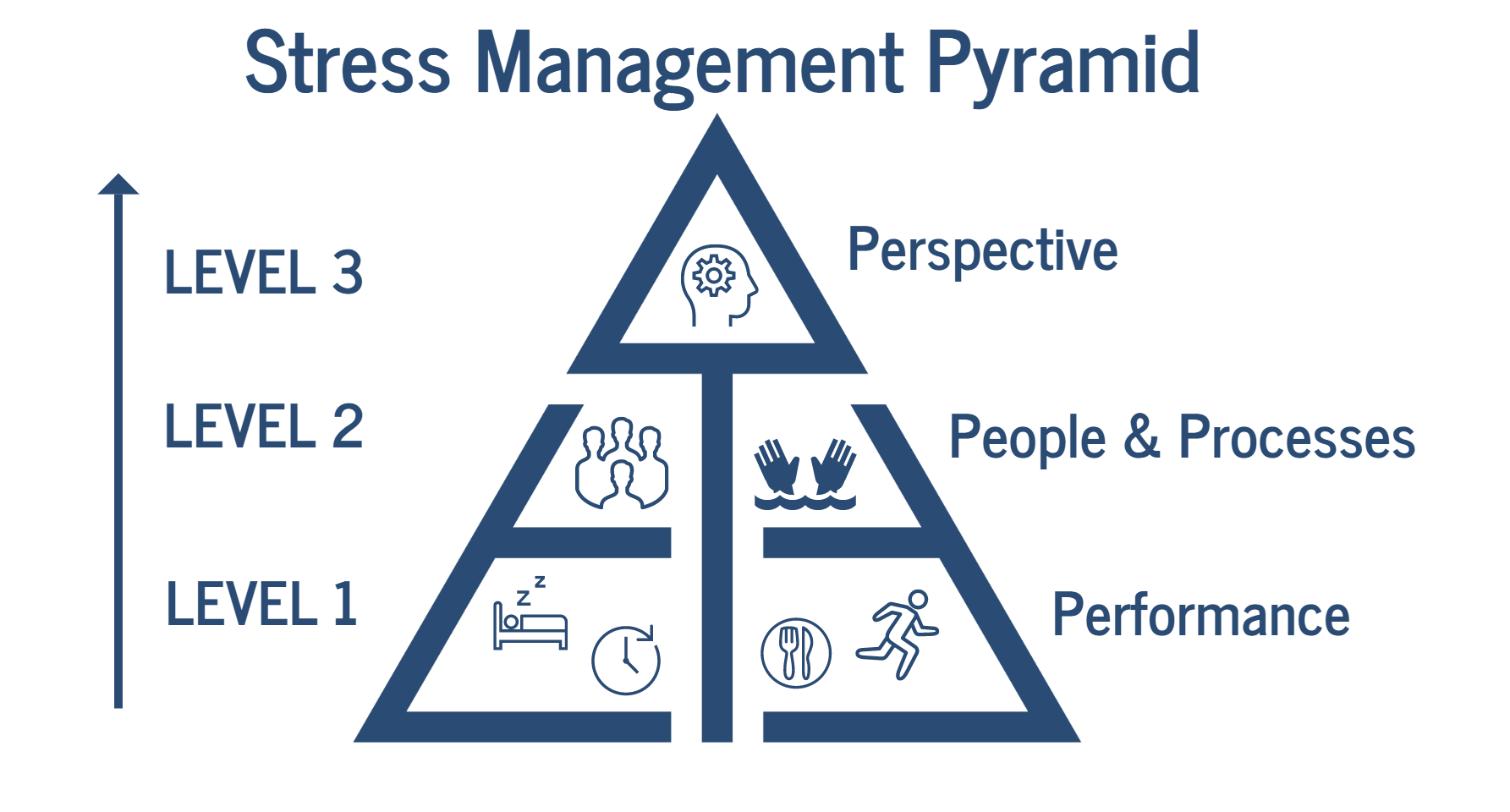
Image by Pamela Coburn-Litvak on Venngage
The Stress Management Pyramid was originally developed by Dr. Skip MacCarty, DMin. Here, I’ve adapted his pyramid to demonstrate the best techniques to manage job stress.
There are three levels to consider.
Level 1 Stress Management Techniques for Job Stress:
In order to build a strong foundation for the rest, we must make healthy lifestyle choices like getting quality rest, good nutrition, exercise, and learning how to manage our time well. Brain and body health are intimately connected, which means that if we take care of our physical health, good mental health is likely to follow. With peak mental performance, we will feel much more equal to any stressful task at hand.
Level 2 Stress Management Techniques for Job Stress:
At the second level, we address our workplace stressors at their source. You may remember from the survey data above that much of job stress boils down to either the people we work with or inefficient work processes.
As an executive coach, I give my clients specific and powerful tools to deal with problems like team engagement, conflict resolution, and changing institutional culture. If you are interested in working with me, I’d love to hear from you. You can learn more about me on this website.
Level 3 Stress Management Techniques for Job Stress:
Here, I use my background in neuroscience and psychology with my clients to tackle thoughts and behaviors that may be causing them stress. A change in perspective is often the key in releasing ourselves from stress, depression, and anxiety.
3 Quick Tips for Level 1 Stress Management
Summarizing these techniques is beyond the scope of this article. But let me share three quick tips to finish up this article:
1. Focus your time and energy on what you can control. Sounds simple, but it’s hard to do. How often do you and I worry and stress out over things at work that we can’t control? This exercise in futility is sure to raise our blood pressure but have very little impact on the stressful circumstances.
2. Keep things in perspective. Many successful stress managers use a stress scale, an imaginary scale from one to ten, with one being low stress and ten being severe stress, like learning you have cancer. When things are heating up at work, ask yourself, “Where would this situation realistically fall on my stress scale? Is it really as bad as I think it is, or is it quite minor in the grand scheme of things?”
3. Focus on what you can learn from stress. Time and again, those who show the most resilience to stressful situations are those who look at them as an opportunity to learn and grow. What’s stressing you out right now? How might that situation possibly stretch you, improve your skills, and force you to grow in ways you haven’t before? When resilient individuals encounter crisis, they think opportunity. You can, too.
Conclusion
To learn more about the stress management pyramid and working with me, please contact me. I’d love to hear from you.
[1] Ganesh, R., Mahapatra, S., Fuehrer, D. L., Folkert, L. J., Jack, W. A., Jenkins, S. M., Bauer, B. A., Wahner-Roedler, D. L., & Sood, A. (2018). The Stressed Executive: Sources and Predictors of Stress Among Participants in an Executive Health Program. Global advances in health and medicine, 7, 2164956118806150. https://doi.org/10.1177/2164956118806150
[2] https://www.wrike.com/blog/stress-epidemic-report-announcement/
[3] Data for this article is a summary from workplace stress surveys conducted by four for-profits (Wrike, Dynamic Signal, Korn Ferry, and Morneau Shepell) and two non-profits (Anxiety & Depression Association of America, Mental Health America). More information about each can be found at their respective websites:
Wrike: https://www.wrike.com/blog/stress-epidemic-report-announcement/
Dynamic Signal: https://dynamicsignal.com/2019/03/20/2019-employee-communication-and-engagement-study/
Korn Ferry: https://www.kornferry.com/insights/articles/workplace-stress-motivation
Morneau Shepell: https://us.morneaushepell.com/resources/anxiety-and-work-impact-anxiety-different-generations-employees
Anxiety & Depression Association of America: https://adaa.org/workplace-stress-anxiety-disorders-survey
Mental Health America: https://www.mhanational.org/sites/default/files/Work%20Health%20Survey%202019.pdf

